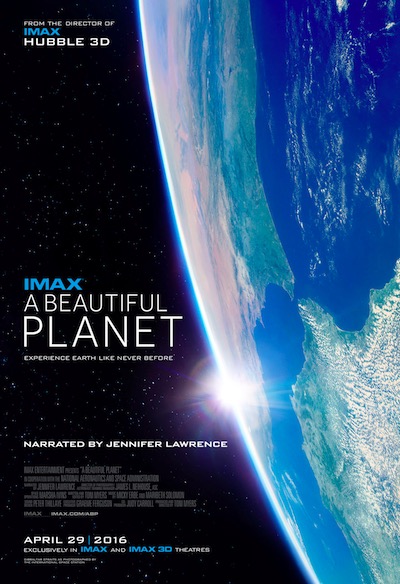Review: A Beautiful Planetby Jeff Foust
|
| Despite its title, the 3-D format of A Beautiful Planet is best on display not in those views of the Earth but rather in those sections filmed on the station. |
A Beautiful Planet hews to that familiar formula. This time the action takes place on the ISS, with actress Jennifer Lawrence providing the narration. The film follows the activities of crews on the ISS in 2014 and 2015, with a particular emphasis on their observations of the Earth, as the title suggests.
The movie alternates between views of the Earth taken from the station and life on the station itself. The former are sometimes a disjointed collection of images, described by Lawrence with occasional comments from astronauts like Terry Virts, Butch Wilmore, and Samantha Cristoforetti. Other times, those images are part of a theme, be it how viewing the Earth at night from space reveals humanity’s presence there, or noticing the effects of the Earth’s changing climate.
Despite its title, the 3-D format of A Beautiful Planet is best on display not in those views of the Earth but rather in those sections filmed on the station. (“Filmed” is an anachronism: the movie’s producers abandoned the classic IMAX 70-millimeter film cameras used in its previous space movies as they are too large to go to space in the post-shuttle era. Instead, the movie was shot on digital cinema cameras that are smaller, but produce sharper images.) Whether it’s mundane activities on the station like exercising or transporting cargo, or following a spacewalk outside the station, the 3-D format excels. One brief sequence, taken from the point of view of a crewmember going from one part of the station to another, captures better than perhaps any other video how disorienting movement inside the station in zero gravity can be.
| At a recent weekday afternoon screening at the National Air and Space Museum in Washington, the theater was mostly empty, even as the museum’s halls were thick with tourists. |
This alternation between life on the station and viewing the Earth from the station does have a subtle theme, that being the fragility of life. Cristoforetti, near the end of the movie, notes that, just as ISS crewmembers have to work together to keep the station operating, the people of Earth must also work together to protect the planet’s environment. It’s hardly an original sentiment, but the movie’s imagery gives it new weight.
There’s a question of whether that familiar formula of IMAX space movies has run its course. It does not appear to be a must-see: ticket sales have been modest since its release in late April. (At a recent weekday afternoon screening at the National Air and Space Museum in Washington, the theater was mostly empty, even as the museum’s halls were thick with tourists.) And, perhaps in the not-too-distant future, we’ll skip the IMAX movies in favor of strapping on virtual reality headsets: one company has proposed installing a VR camera system outside the ISS, for example. In the meantime, though, movies like A Beautiful Planet offer some of the best ways for those of us stuck on Earth to see what life is like off it, or get a new perspective on life on it.
